Challenges of Communication in a Multicultural Workplace
VerifiedAdded on 2022/10/02
|11
|1928
|370
Report
AI Summary
This report presents a research study conducted to evaluate the communication challenges within a multicultural workforce, specifically focusing on an eatery in Bangkok, Thailand. The research, based on an interview with the general manager, Jane, identifies language barriers, cultural differences, and varying communication styles as primary obstacles. The findings highlight how accents, native languages, and differing cultural norms hinder effective communication during presentations, negotiations, meetings, and conflict resolution. The study underscores the need for strategies like English language training and policies against native language use to foster a more cohesive and productive work environment. The report concludes with recommendations for policy development and training programs to improve communication, ensuring better outcomes and a more positive workplace for all employees.
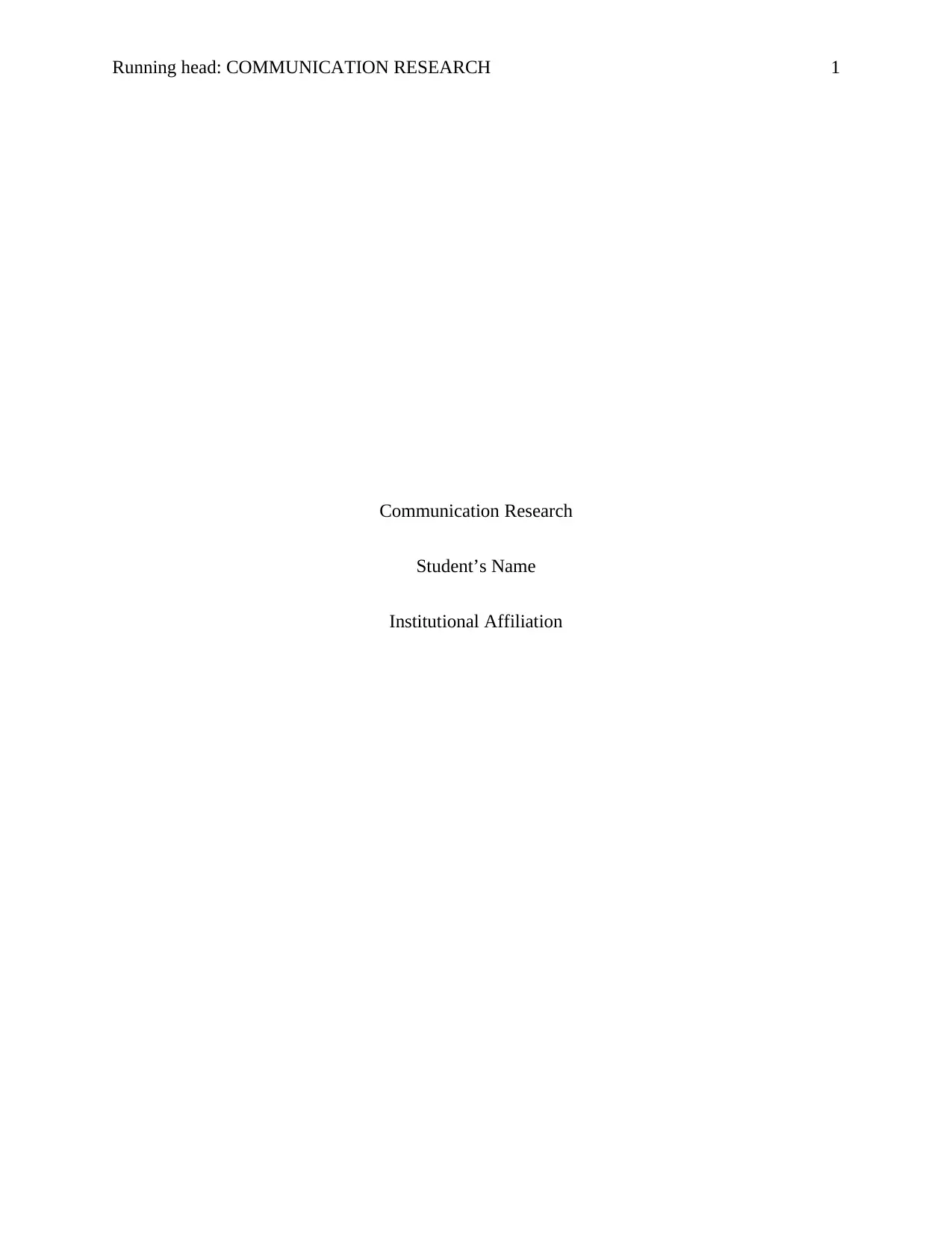
Running head: COMMUNICATION RESEARCH 1
Communication Research
Student’s Name
Institutional Affiliation
Communication Research
Student’s Name
Institutional Affiliation
Paraphrase This Document
Need a fresh take? Get an instant paraphrase of this document with our AI Paraphraser
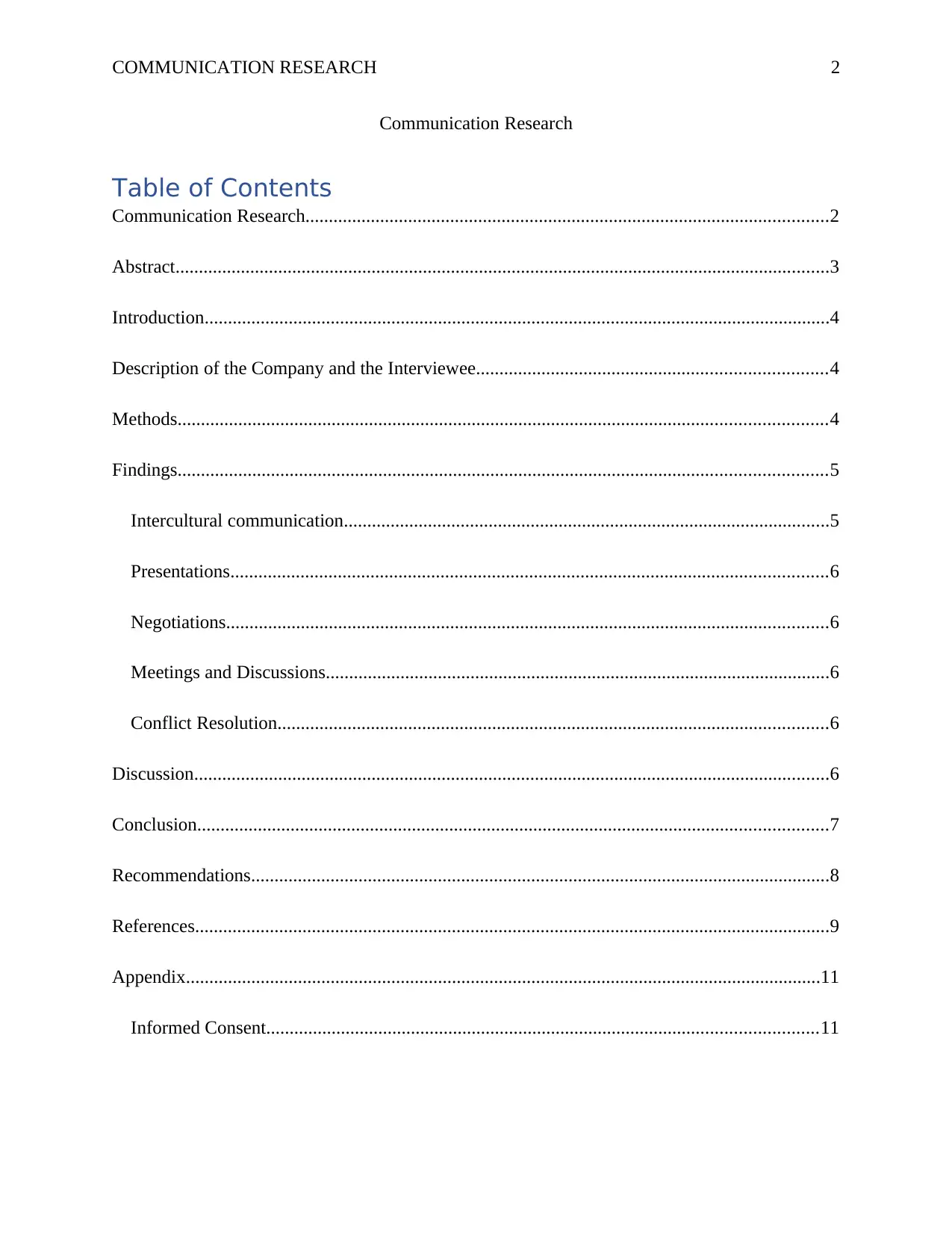
COMMUNICATION RESEARCH 2
Communication Research
Table of Contents
Communication Research................................................................................................................2
Abstract............................................................................................................................................3
Introduction......................................................................................................................................4
Description of the Company and the Interviewee...........................................................................4
Methods...........................................................................................................................................4
Findings...........................................................................................................................................5
Intercultural communication........................................................................................................5
Presentations................................................................................................................................6
Negotiations.................................................................................................................................6
Meetings and Discussions............................................................................................................6
Conflict Resolution......................................................................................................................6
Discussion........................................................................................................................................6
Conclusion.......................................................................................................................................7
Recommendations............................................................................................................................8
References........................................................................................................................................9
Appendix........................................................................................................................................11
Informed Consent......................................................................................................................11
Communication Research
Table of Contents
Communication Research................................................................................................................2
Abstract............................................................................................................................................3
Introduction......................................................................................................................................4
Description of the Company and the Interviewee...........................................................................4
Methods...........................................................................................................................................4
Findings...........................................................................................................................................5
Intercultural communication........................................................................................................5
Presentations................................................................................................................................6
Negotiations.................................................................................................................................6
Meetings and Discussions............................................................................................................6
Conflict Resolution......................................................................................................................6
Discussion........................................................................................................................................6
Conclusion.......................................................................................................................................7
Recommendations............................................................................................................................8
References........................................................................................................................................9
Appendix........................................................................................................................................11
Informed Consent......................................................................................................................11
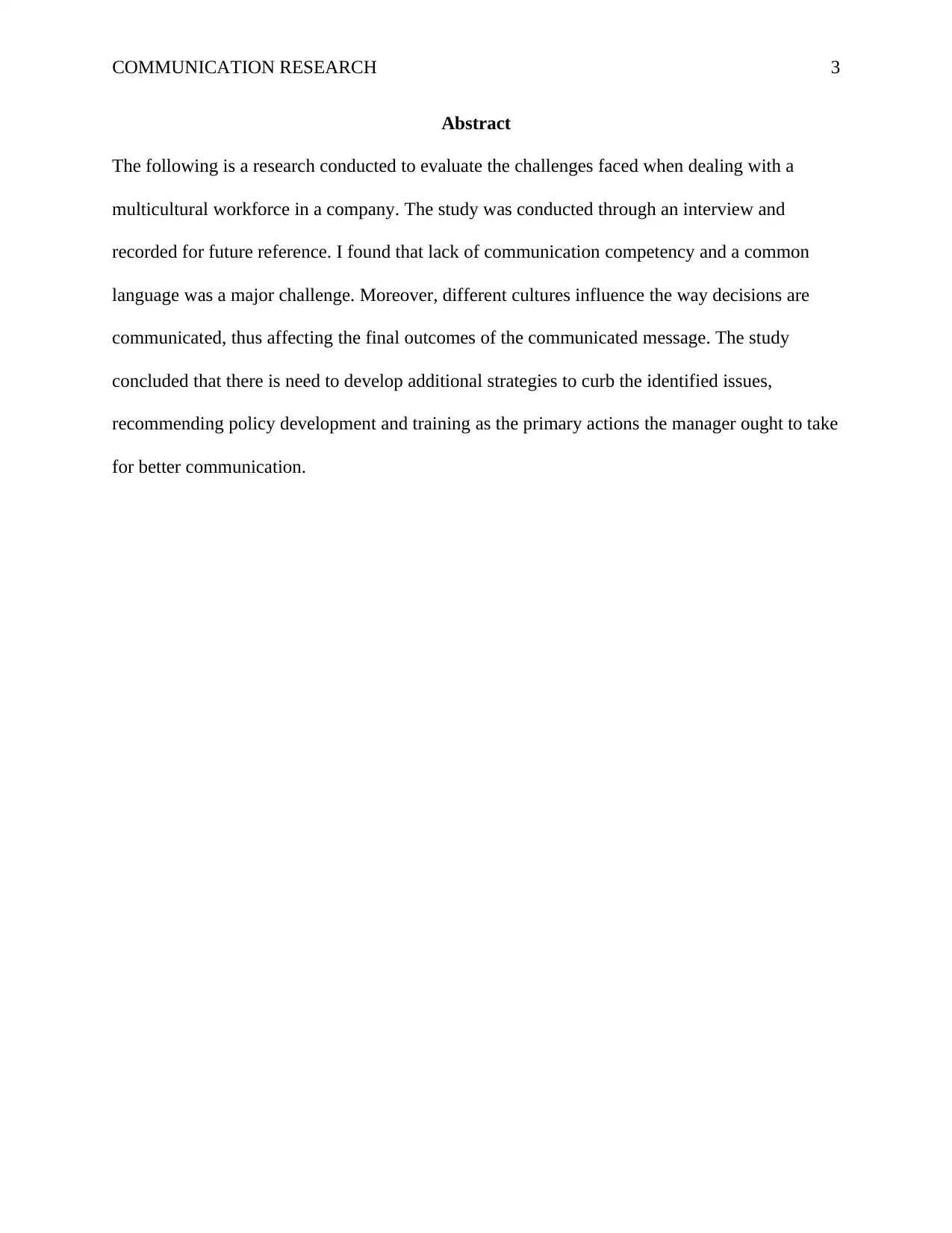
COMMUNICATION RESEARCH 3
Abstract
The following is a research conducted to evaluate the challenges faced when dealing with a
multicultural workforce in a company. The study was conducted through an interview and
recorded for future reference. I found that lack of communication competency and a common
language was a major challenge. Moreover, different cultures influence the way decisions are
communicated, thus affecting the final outcomes of the communicated message. The study
concluded that there is need to develop additional strategies to curb the identified issues,
recommending policy development and training as the primary actions the manager ought to take
for better communication.
Abstract
The following is a research conducted to evaluate the challenges faced when dealing with a
multicultural workforce in a company. The study was conducted through an interview and
recorded for future reference. I found that lack of communication competency and a common
language was a major challenge. Moreover, different cultures influence the way decisions are
communicated, thus affecting the final outcomes of the communicated message. The study
concluded that there is need to develop additional strategies to curb the identified issues,
recommending policy development and training as the primary actions the manager ought to take
for better communication.
⊘ This is a preview!⊘
Do you want full access?
Subscribe today to unlock all pages.

Trusted by 1+ million students worldwide
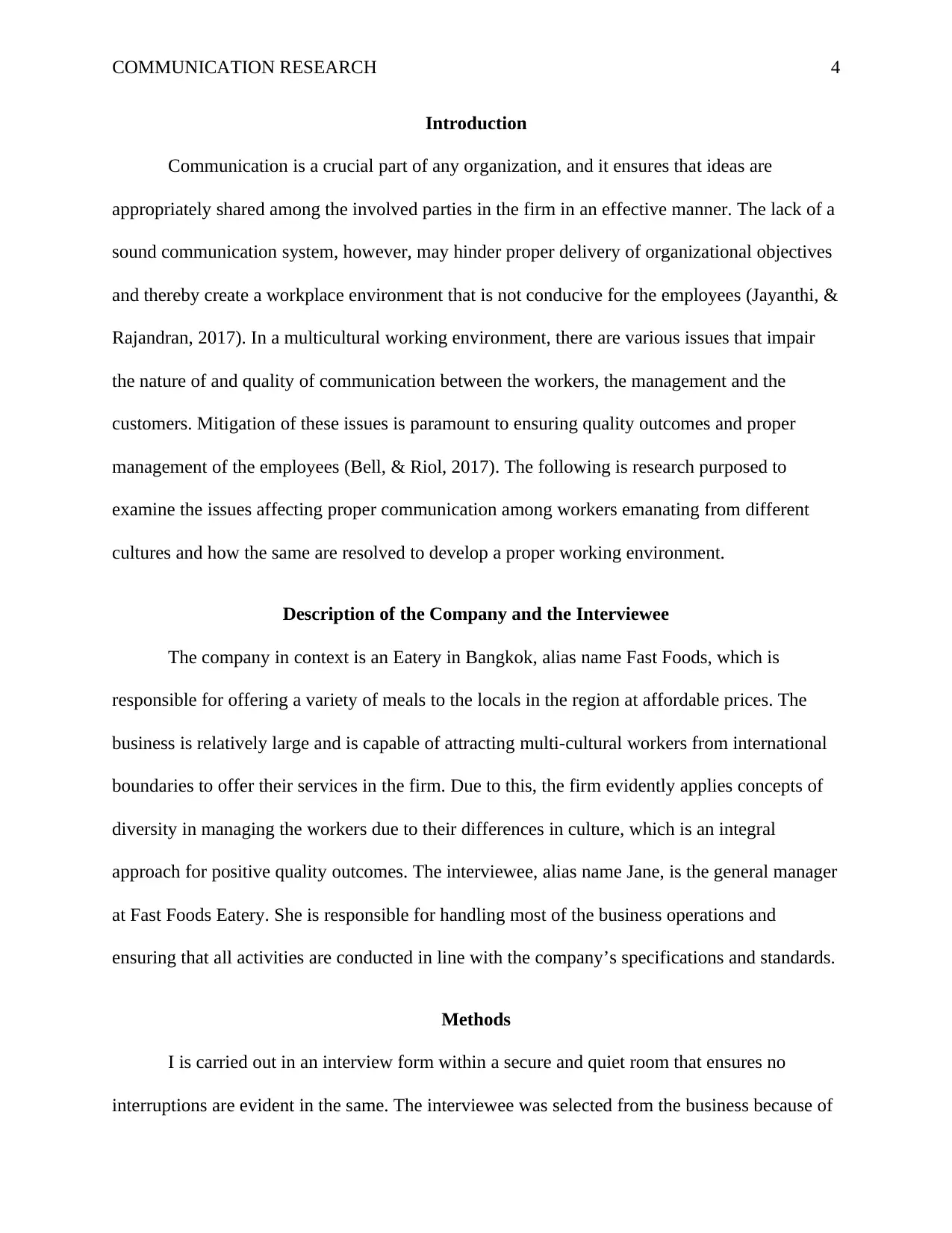
COMMUNICATION RESEARCH 4
Introduction
Communication is a crucial part of any organization, and it ensures that ideas are
appropriately shared among the involved parties in the firm in an effective manner. The lack of a
sound communication system, however, may hinder proper delivery of organizational objectives
and thereby create a workplace environment that is not conducive for the employees (Jayanthi, &
Rajandran, 2017). In a multicultural working environment, there are various issues that impair
the nature of and quality of communication between the workers, the management and the
customers. Mitigation of these issues is paramount to ensuring quality outcomes and proper
management of the employees (Bell, & Riol, 2017). The following is research purposed to
examine the issues affecting proper communication among workers emanating from different
cultures and how the same are resolved to develop a proper working environment.
Description of the Company and the Interviewee
The company in context is an Eatery in Bangkok, alias name Fast Foods, which is
responsible for offering a variety of meals to the locals in the region at affordable prices. The
business is relatively large and is capable of attracting multi-cultural workers from international
boundaries to offer their services in the firm. Due to this, the firm evidently applies concepts of
diversity in managing the workers due to their differences in culture, which is an integral
approach for positive quality outcomes. The interviewee, alias name Jane, is the general manager
at Fast Foods Eatery. She is responsible for handling most of the business operations and
ensuring that all activities are conducted in line with the company’s specifications and standards.
Methods
I is carried out in an interview form within a secure and quiet room that ensures no
interruptions are evident in the same. The interviewee was selected from the business because of
Introduction
Communication is a crucial part of any organization, and it ensures that ideas are
appropriately shared among the involved parties in the firm in an effective manner. The lack of a
sound communication system, however, may hinder proper delivery of organizational objectives
and thereby create a workplace environment that is not conducive for the employees (Jayanthi, &
Rajandran, 2017). In a multicultural working environment, there are various issues that impair
the nature of and quality of communication between the workers, the management and the
customers. Mitigation of these issues is paramount to ensuring quality outcomes and proper
management of the employees (Bell, & Riol, 2017). The following is research purposed to
examine the issues affecting proper communication among workers emanating from different
cultures and how the same are resolved to develop a proper working environment.
Description of the Company and the Interviewee
The company in context is an Eatery in Bangkok, alias name Fast Foods, which is
responsible for offering a variety of meals to the locals in the region at affordable prices. The
business is relatively large and is capable of attracting multi-cultural workers from international
boundaries to offer their services in the firm. Due to this, the firm evidently applies concepts of
diversity in managing the workers due to their differences in culture, which is an integral
approach for positive quality outcomes. The interviewee, alias name Jane, is the general manager
at Fast Foods Eatery. She is responsible for handling most of the business operations and
ensuring that all activities are conducted in line with the company’s specifications and standards.
Methods
I is carried out in an interview form within a secure and quiet room that ensures no
interruptions are evident in the same. The interviewee was selected from the business because of
Paraphrase This Document
Need a fresh take? Get an instant paraphrase of this document with our AI Paraphraser
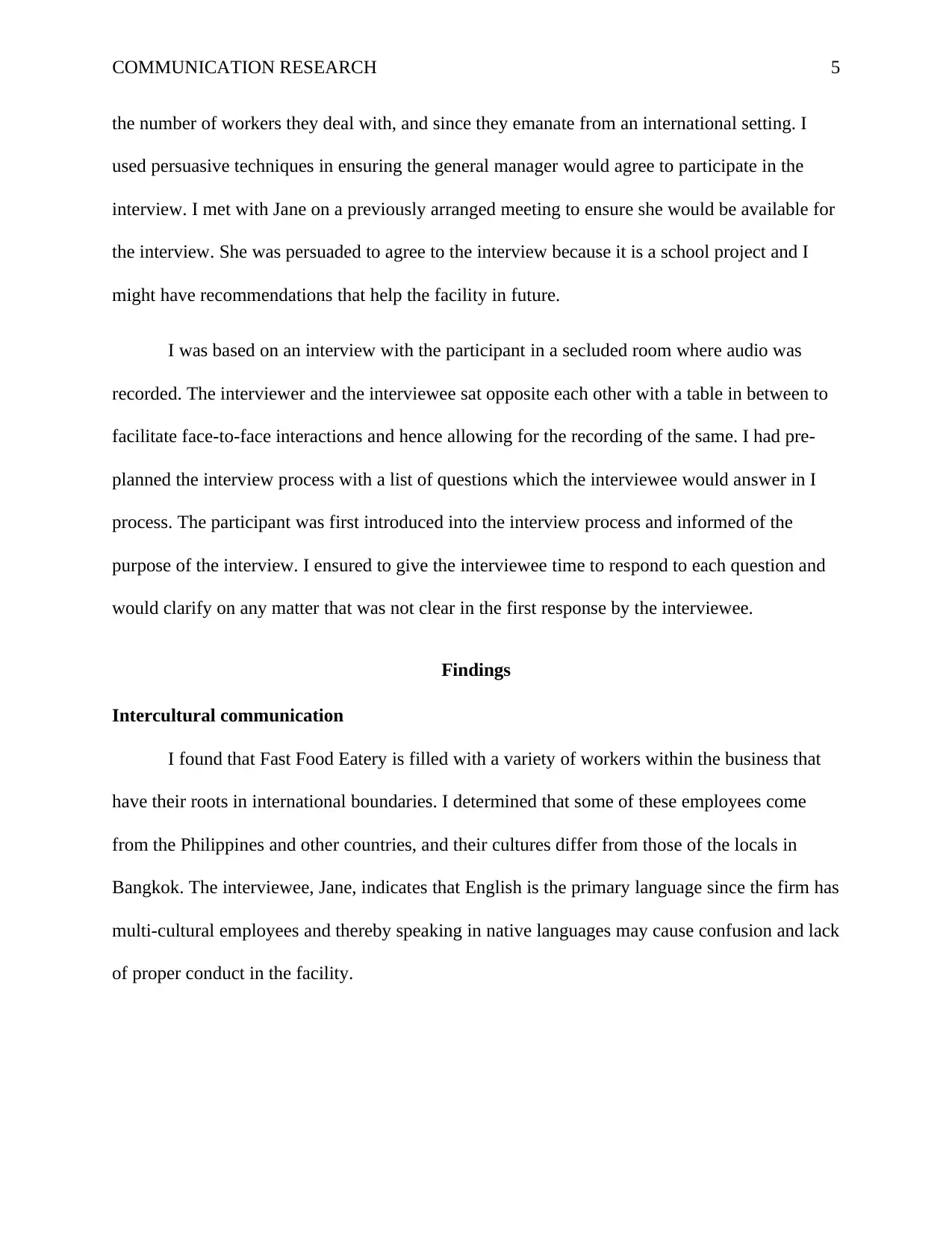
COMMUNICATION RESEARCH 5
the number of workers they deal with, and since they emanate from an international setting. I
used persuasive techniques in ensuring the general manager would agree to participate in the
interview. I met with Jane on a previously arranged meeting to ensure she would be available for
the interview. She was persuaded to agree to the interview because it is a school project and I
might have recommendations that help the facility in future.
I was based on an interview with the participant in a secluded room where audio was
recorded. The interviewer and the interviewee sat opposite each other with a table in between to
facilitate face-to-face interactions and hence allowing for the recording of the same. I had pre-
planned the interview process with a list of questions which the interviewee would answer in I
process. The participant was first introduced into the interview process and informed of the
purpose of the interview. I ensured to give the interviewee time to respond to each question and
would clarify on any matter that was not clear in the first response by the interviewee.
Findings
Intercultural communication
I found that Fast Food Eatery is filled with a variety of workers within the business that
have their roots in international boundaries. I determined that some of these employees come
from the Philippines and other countries, and their cultures differ from those of the locals in
Bangkok. The interviewee, Jane, indicates that English is the primary language since the firm has
multi-cultural employees and thereby speaking in native languages may cause confusion and lack
of proper conduct in the facility.
the number of workers they deal with, and since they emanate from an international setting. I
used persuasive techniques in ensuring the general manager would agree to participate in the
interview. I met with Jane on a previously arranged meeting to ensure she would be available for
the interview. She was persuaded to agree to the interview because it is a school project and I
might have recommendations that help the facility in future.
I was based on an interview with the participant in a secluded room where audio was
recorded. The interviewer and the interviewee sat opposite each other with a table in between to
facilitate face-to-face interactions and hence allowing for the recording of the same. I had pre-
planned the interview process with a list of questions which the interviewee would answer in I
process. The participant was first introduced into the interview process and informed of the
purpose of the interview. I ensured to give the interviewee time to respond to each question and
would clarify on any matter that was not clear in the first response by the interviewee.
Findings
Intercultural communication
I found that Fast Food Eatery is filled with a variety of workers within the business that
have their roots in international boundaries. I determined that some of these employees come
from the Philippines and other countries, and their cultures differ from those of the locals in
Bangkok. The interviewee, Jane, indicates that English is the primary language since the firm has
multi-cultural employees and thereby speaking in native languages may cause confusion and lack
of proper conduct in the facility.
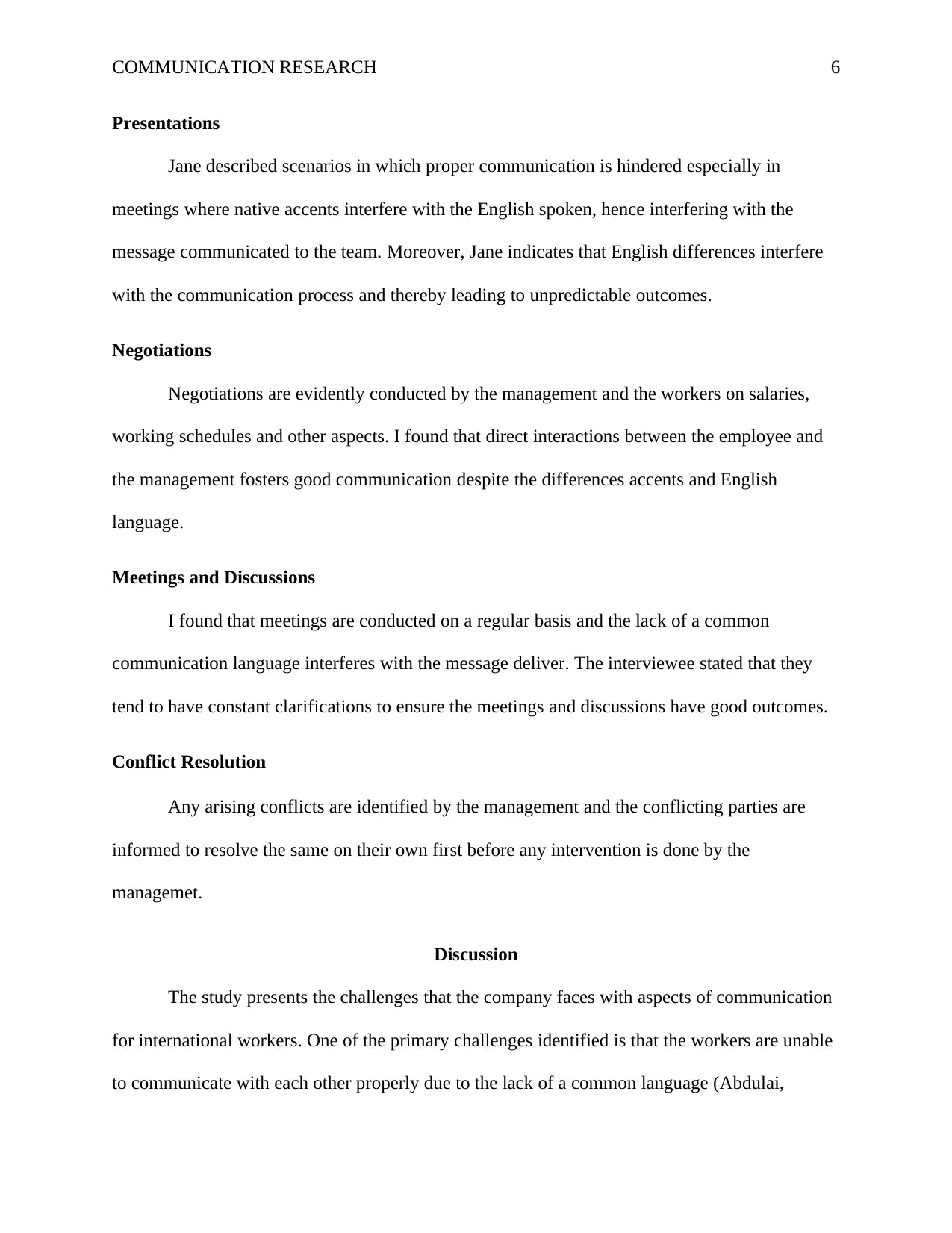
COMMUNICATION RESEARCH 6
Presentations
Jane described scenarios in which proper communication is hindered especially in
meetings where native accents interfere with the English spoken, hence interfering with the
message communicated to the team. Moreover, Jane indicates that English differences interfere
with the communication process and thereby leading to unpredictable outcomes.
Negotiations
Negotiations are evidently conducted by the management and the workers on salaries,
working schedules and other aspects. I found that direct interactions between the employee and
the management fosters good communication despite the differences accents and English
language.
Meetings and Discussions
I found that meetings are conducted on a regular basis and the lack of a common
communication language interferes with the message deliver. The interviewee stated that they
tend to have constant clarifications to ensure the meetings and discussions have good outcomes.
Conflict Resolution
Any arising conflicts are identified by the management and the conflicting parties are
informed to resolve the same on their own first before any intervention is done by the
managemet.
Discussion
The study presents the challenges that the company faces with aspects of communication
for international workers. One of the primary challenges identified is that the workers are unable
to communicate with each other properly due to the lack of a common language (Abdulai,
Presentations
Jane described scenarios in which proper communication is hindered especially in
meetings where native accents interfere with the English spoken, hence interfering with the
message communicated to the team. Moreover, Jane indicates that English differences interfere
with the communication process and thereby leading to unpredictable outcomes.
Negotiations
Negotiations are evidently conducted by the management and the workers on salaries,
working schedules and other aspects. I found that direct interactions between the employee and
the management fosters good communication despite the differences accents and English
language.
Meetings and Discussions
I found that meetings are conducted on a regular basis and the lack of a common
communication language interferes with the message deliver. The interviewee stated that they
tend to have constant clarifications to ensure the meetings and discussions have good outcomes.
Conflict Resolution
Any arising conflicts are identified by the management and the conflicting parties are
informed to resolve the same on their own first before any intervention is done by the
managemet.
Discussion
The study presents the challenges that the company faces with aspects of communication
for international workers. One of the primary challenges identified is that the workers are unable
to communicate with each other properly due to the lack of a common language (Abdulai,
⊘ This is a preview!⊘
Do you want full access?
Subscribe today to unlock all pages.

Trusted by 1+ million students worldwide
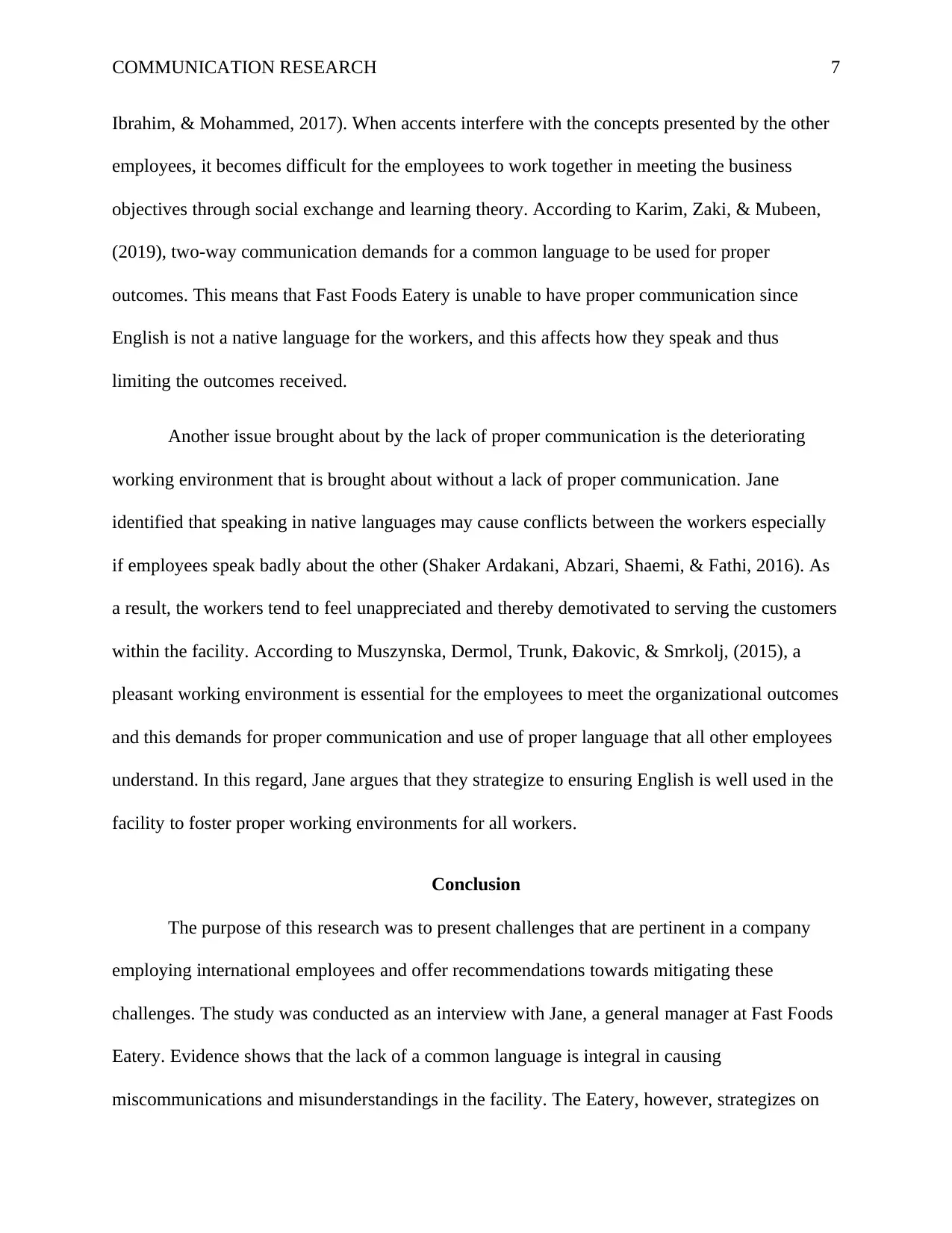
COMMUNICATION RESEARCH 7
Ibrahim, & Mohammed, 2017). When accents interfere with the concepts presented by the other
employees, it becomes difficult for the employees to work together in meeting the business
objectives through social exchange and learning theory. According to Karim, Zaki, & Mubeen,
(2019), two-way communication demands for a common language to be used for proper
outcomes. This means that Fast Foods Eatery is unable to have proper communication since
English is not a native language for the workers, and this affects how they speak and thus
limiting the outcomes received.
Another issue brought about by the lack of proper communication is the deteriorating
working environment that is brought about without a lack of proper communication. Jane
identified that speaking in native languages may cause conflicts between the workers especially
if employees speak badly about the other (Shaker Ardakani, Abzari, Shaemi, & Fathi, 2016). As
a result, the workers tend to feel unappreciated and thereby demotivated to serving the customers
within the facility. According to Muszynska, Dermol, Trunk, Ðakovic, & Smrkolj, (2015), a
pleasant working environment is essential for the employees to meet the organizational outcomes
and this demands for proper communication and use of proper language that all other employees
understand. In this regard, Jane argues that they strategize to ensuring English is well used in the
facility to foster proper working environments for all workers.
Conclusion
The purpose of this research was to present challenges that are pertinent in a company
employing international employees and offer recommendations towards mitigating these
challenges. The study was conducted as an interview with Jane, a general manager at Fast Foods
Eatery. Evidence shows that the lack of a common language is integral in causing
miscommunications and misunderstandings in the facility. The Eatery, however, strategizes on
Ibrahim, & Mohammed, 2017). When accents interfere with the concepts presented by the other
employees, it becomes difficult for the employees to work together in meeting the business
objectives through social exchange and learning theory. According to Karim, Zaki, & Mubeen,
(2019), two-way communication demands for a common language to be used for proper
outcomes. This means that Fast Foods Eatery is unable to have proper communication since
English is not a native language for the workers, and this affects how they speak and thus
limiting the outcomes received.
Another issue brought about by the lack of proper communication is the deteriorating
working environment that is brought about without a lack of proper communication. Jane
identified that speaking in native languages may cause conflicts between the workers especially
if employees speak badly about the other (Shaker Ardakani, Abzari, Shaemi, & Fathi, 2016). As
a result, the workers tend to feel unappreciated and thereby demotivated to serving the customers
within the facility. According to Muszynska, Dermol, Trunk, Ðakovic, & Smrkolj, (2015), a
pleasant working environment is essential for the employees to meet the organizational outcomes
and this demands for proper communication and use of proper language that all other employees
understand. In this regard, Jane argues that they strategize to ensuring English is well used in the
facility to foster proper working environments for all workers.
Conclusion
The purpose of this research was to present challenges that are pertinent in a company
employing international employees and offer recommendations towards mitigating these
challenges. The study was conducted as an interview with Jane, a general manager at Fast Foods
Eatery. Evidence shows that the lack of a common language is integral in causing
miscommunications and misunderstandings in the facility. The Eatery, however, strategizes on
Paraphrase This Document
Need a fresh take? Get an instant paraphrase of this document with our AI Paraphraser

COMMUNICATION RESEARCH 8
ensuring English is used as a common language among all the workers within the facility as a
way to curb the issue and have proper organizational outcomes.
Recommendations
Despite Fast Foods having proper strategies to curb the identified issues, there are more
recommendations that can be essential for their development. These recommendations are as
follows:
Develop an initiation plan for the new workers that allows them to be trained in English
despite their origin (Ravazzani, 2016). This will help to ensure a common language is
used across the organization for all communications.
Design policies guiding employees against the use of their native language in the
workplace and state the measures taken to individuals found to violate the policy (Alemu,
2016).
Ensure feedback is taken positively as a way to develop and grow the employee’s
confidence, language and competency in the workplace.
ensuring English is used as a common language among all the workers within the facility as a
way to curb the issue and have proper organizational outcomes.
Recommendations
Despite Fast Foods having proper strategies to curb the identified issues, there are more
recommendations that can be essential for their development. These recommendations are as
follows:
Develop an initiation plan for the new workers that allows them to be trained in English
despite their origin (Ravazzani, 2016). This will help to ensure a common language is
used across the organization for all communications.
Design policies guiding employees against the use of their native language in the
workplace and state the measures taken to individuals found to violate the policy (Alemu,
2016).
Ensure feedback is taken positively as a way to develop and grow the employee’s
confidence, language and competency in the workplace.
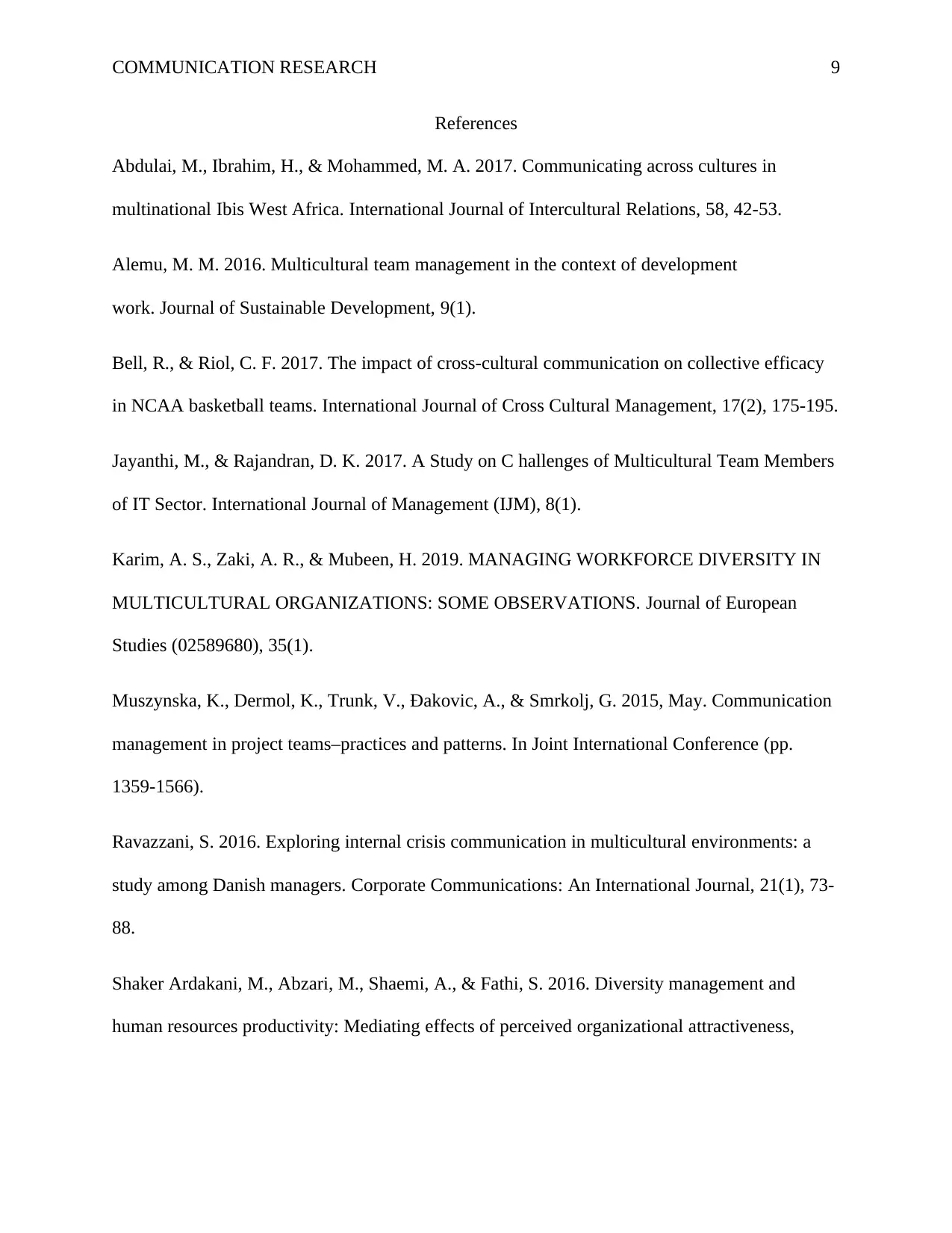
COMMUNICATION RESEARCH 9
References
Abdulai, M., Ibrahim, H., & Mohammed, M. A. 2017. Communicating across cultures in
multinational Ibis West Africa. International Journal of Intercultural Relations, 58, 42-53.
Alemu, M. M. 2016. Multicultural team management in the context of development
work. Journal of Sustainable Development, 9(1).
Bell, R., & Riol, C. F. 2017. The impact of cross-cultural communication on collective efficacy
in NCAA basketball teams. International Journal of Cross Cultural Management, 17(2), 175-195.
Jayanthi, M., & Rajandran, D. K. 2017. A Study on C hallenges of Multicultural Team Members
of IT Sector. International Journal of Management (IJM), 8(1).
Karim, A. S., Zaki, A. R., & Mubeen, H. 2019. MANAGING WORKFORCE DIVERSITY IN
MULTICULTURAL ORGANIZATIONS: SOME OBSERVATIONS. Journal of European
Studies (02589680), 35(1).
Muszynska, K., Dermol, K., Trunk, V., Ðakovic, A., & Smrkolj, G. 2015, May. Communication
management in project teams–practices and patterns. In Joint International Conference (pp.
1359-1566).
Ravazzani, S. 2016. Exploring internal crisis communication in multicultural environments: a
study among Danish managers. Corporate Communications: An International Journal, 21(1), 73-
88.
Shaker Ardakani, M., Abzari, M., Shaemi, A., & Fathi, S. 2016. Diversity management and
human resources productivity: Mediating effects of perceived organizational attractiveness,
References
Abdulai, M., Ibrahim, H., & Mohammed, M. A. 2017. Communicating across cultures in
multinational Ibis West Africa. International Journal of Intercultural Relations, 58, 42-53.
Alemu, M. M. 2016. Multicultural team management in the context of development
work. Journal of Sustainable Development, 9(1).
Bell, R., & Riol, C. F. 2017. The impact of cross-cultural communication on collective efficacy
in NCAA basketball teams. International Journal of Cross Cultural Management, 17(2), 175-195.
Jayanthi, M., & Rajandran, D. K. 2017. A Study on C hallenges of Multicultural Team Members
of IT Sector. International Journal of Management (IJM), 8(1).
Karim, A. S., Zaki, A. R., & Mubeen, H. 2019. MANAGING WORKFORCE DIVERSITY IN
MULTICULTURAL ORGANIZATIONS: SOME OBSERVATIONS. Journal of European
Studies (02589680), 35(1).
Muszynska, K., Dermol, K., Trunk, V., Ðakovic, A., & Smrkolj, G. 2015, May. Communication
management in project teams–practices and patterns. In Joint International Conference (pp.
1359-1566).
Ravazzani, S. 2016. Exploring internal crisis communication in multicultural environments: a
study among Danish managers. Corporate Communications: An International Journal, 21(1), 73-
88.
Shaker Ardakani, M., Abzari, M., Shaemi, A., & Fathi, S. 2016. Diversity management and
human resources productivity: Mediating effects of perceived organizational attractiveness,
⊘ This is a preview!⊘
Do you want full access?
Subscribe today to unlock all pages.

Trusted by 1+ million students worldwide
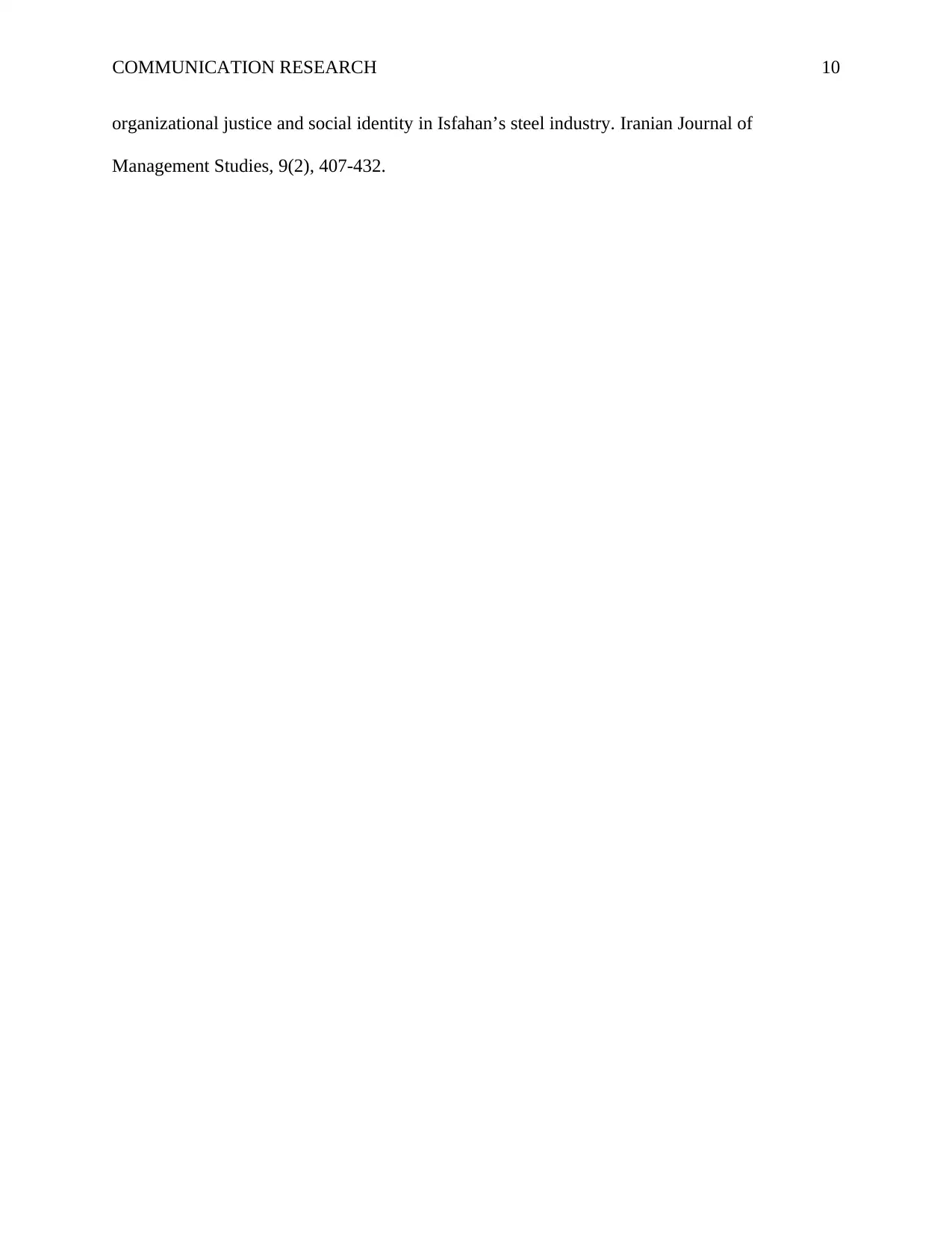
COMMUNICATION RESEARCH 10
organizational justice and social identity in Isfahan’s steel industry. Iranian Journal of
Management Studies, 9(2), 407-432.
organizational justice and social identity in Isfahan’s steel industry. Iranian Journal of
Management Studies, 9(2), 407-432.
Paraphrase This Document
Need a fresh take? Get an instant paraphrase of this document with our AI Paraphraser
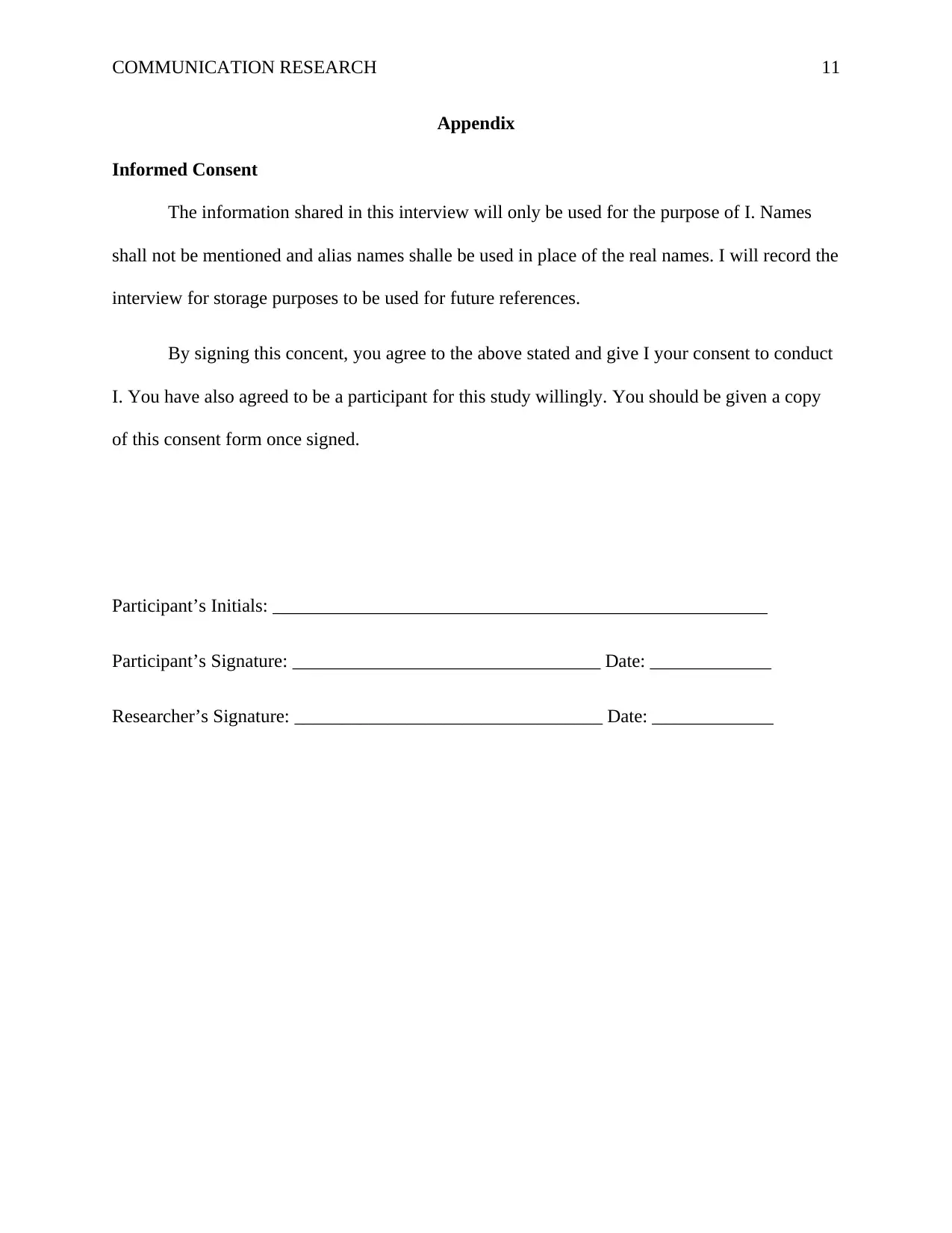
COMMUNICATION RESEARCH 11
Appendix
Informed Consent
The information shared in this interview will only be used for the purpose of I. Names
shall not be mentioned and alias names shalle be used in place of the real names. I will record the
interview for storage purposes to be used for future references.
By signing this concent, you agree to the above stated and give I your consent to conduct
I. You have also agreed to be a participant for this study willingly. You should be given a copy
of this consent form once signed.
Participant’s Initials: _____________________________________________________
Participant’s Signature: _________________________________ Date: _____________
Researcher’s Signature: _________________________________ Date: _____________
Appendix
Informed Consent
The information shared in this interview will only be used for the purpose of I. Names
shall not be mentioned and alias names shalle be used in place of the real names. I will record the
interview for storage purposes to be used for future references.
By signing this concent, you agree to the above stated and give I your consent to conduct
I. You have also agreed to be a participant for this study willingly. You should be given a copy
of this consent form once signed.
Participant’s Initials: _____________________________________________________
Participant’s Signature: _________________________________ Date: _____________
Researcher’s Signature: _________________________________ Date: _____________
1 out of 11
Related Documents
Your All-in-One AI-Powered Toolkit for Academic Success.
+13062052269
info@desklib.com
Available 24*7 on WhatsApp / Email
![[object Object]](/_next/static/media/star-bottom.7253800d.svg)
Unlock your academic potential
Copyright © 2020–2025 A2Z Services. All Rights Reserved. Developed and managed by ZUCOL.





